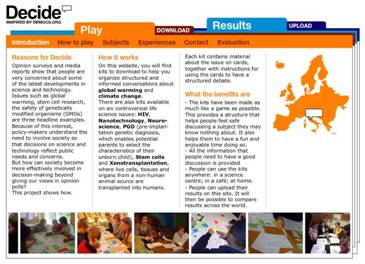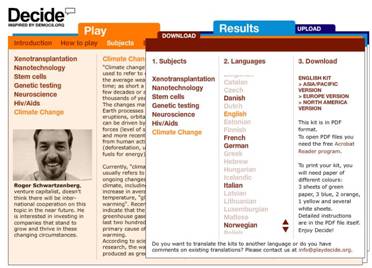Stefka Kitanova 'decides' whether the conversation games on this resource website are useful tools for encouraging structured debate in the science CLIL classroom.
http://www.playdecide.org/ is an e-learning website from Ecsite, the European Network of Science Centers and Museums. It provides free downloadable resources for creating debates and conversation games where students explore the ethics behind a variety of science topics and come to a group policy decision. Topics range from HIV and nanotechnology to global warming and climate change.
My experience with this site is with the topic ‘Climate change’ with students aged 15. There are several good things about this game.
 |
Getting started
You go to the site and choose your topic. From there, the site asks you to choose a language. The different games are available in several languages. When you have chosen which language you want, you download the resources you need.
Structure
The game has four sections:
1) information, where participants read information cards, choose the ones they feel reflect their own opinion;
2) discussion: where participants discuss in groups to identify a larger theme for the cluster sheets;
3) shared group response: where the group tries to reach a consensus and write a common policy;
4) action: participants submit group results to the Decide website.
There are colour coded cards – green (info cards), blue (issue cards), orange (challenge cards) and yellow (story cards) – this helps if you work in a foreign language. White cards are also available if necessary to add extra things.
The game lasts only 80 minutes and the different phases are well-timed; it’s easy to understand and follow the instructions and this also holds true for the site itself.
 |
The game
Now comes the core part: an interesting game!
The participants have to read the cards, choose and share their opinion on them (which means practising their reading and speaking skills from a language learning point of view) and thinking skills, from a content learning point of view. If necessary the participants can add information. Also they have to listen to each other's opinions, argue, give reasons, accept, reject, etc. so they are active during practically all phases of the game.
There is a facilitator who manages the process and keeps an eye on the time. My experience is with groups of 25-26 students divided into groups of 5-7. They work simultaneously and surprisingly it wasn't noisy in the classroom.
The last phase is when the participants have to give their own opinion on the topic. This could be done in three ways: you can choose from given opinions, or add to them, or create your own.
The very last phase is to upload the results.
Other topics
There are also other topics available: xenotransplantation, nanotechnology, stem cells, genetic testing, neuroscience, HIV/AIDS. And I will definitely try them! Probably the best thing is that the topics are available not only in English but in other languages also.
I would definitely recommend this for the science CLIL classroom.
Stefka Kitanova
butsa13@abv.bg

No comments yet